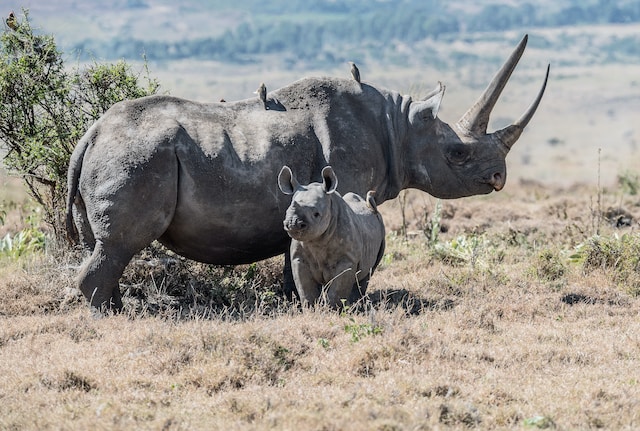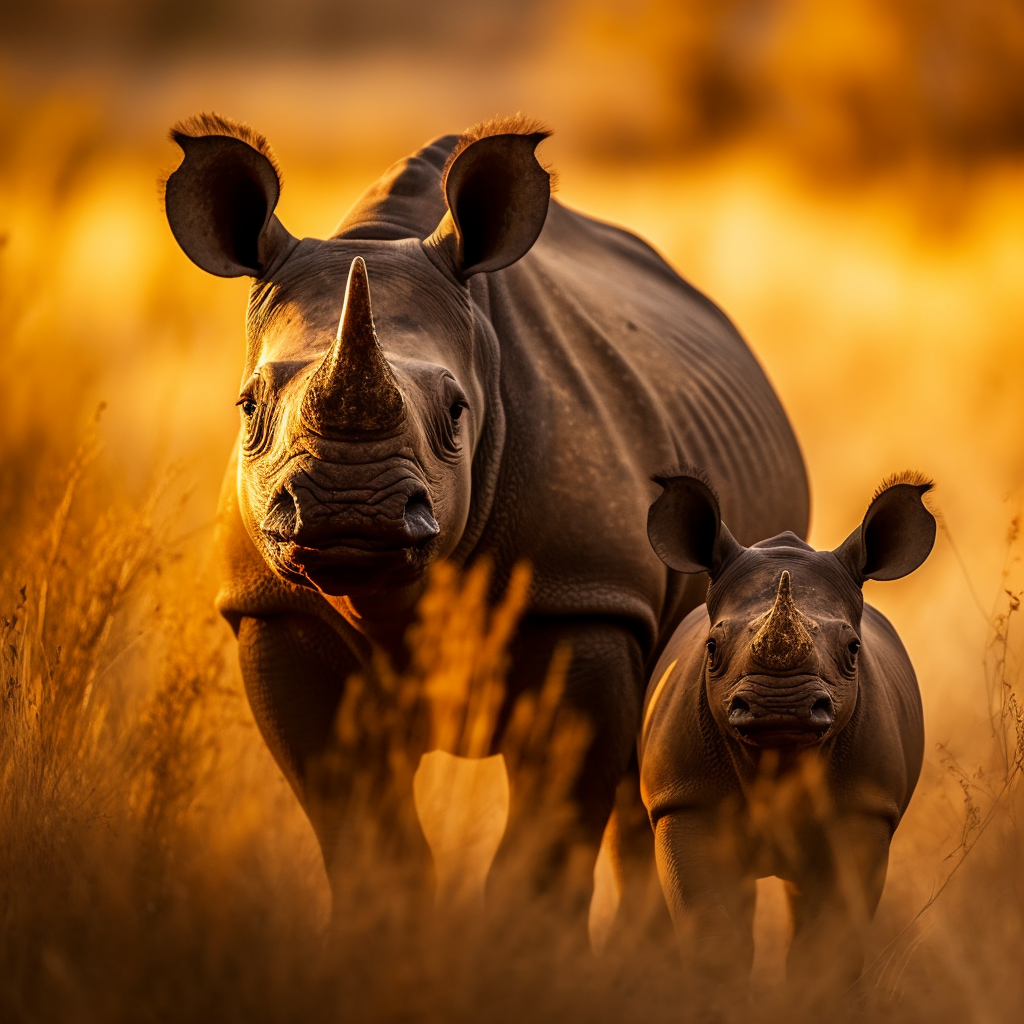KidZone Animals
Rhinoceros

Rhino and calf
Photo by David Clode on Unsplash
Hello, young explorers! Welcome back to Kidzone's animal facts. Today, we're stepping into the world of one of nature's most formidable and magnificent creatures: The Rhinoceros! Let's embark on this exciting journey of discovery!
What is a Rhinoceros?
The word "rhinoceros" comes from the Greek words 'rhino' meaning nose and 'ceros' meaning horn. So, 'rhinoceros' means 'nose horn'. And that makes sense because one of the first things you'll notice about a rhinoceros, or rhino for short, is the big horn (or horns!) on its nose.
Rhinos are part of a group of animals called 'megafauna', which means they are big, powerful, and a bit like the superheroes of the animal kingdom.
Where do Rhinoceroses Live?
Rhinos are native to Africa and Asia. African rhinos live in grasslands and savannahs, while Asian rhinos prefer dense forests and swamps.
There are five different species of rhinos: white and black rhinos in Africa, and Indian, Javan, and Sumatran rhinos in Asia. Each species has its unique characteristics and preferred habitats.
What do Rhinoceroses Eat?
All rhinos are herbivores, which means they only eat plants. Their diet can include leaves, shoots, twigs, branches, and fruit. Some rhinos, like the white rhino, primarily graze on grass, while others, like the black and Indian rhinos, are more into leaves and branches.
How Big Can Rhinoceroses Get?
Rhinos are one of the largest animals on Earth. Depending on the species, they can weigh between 1,800 and 7,000 pounds - that's about as heavy as a car! Rhinos can be 4 to 6 feet tall at the shoulder and 10 to 15 feet long. They are solidly built and have thick, protective skin that can be as much as 2 inches thick in places.
Rhino Babies:
 A baby rhino is called a calf. Just like baby cows, elephants, and whales, newborn rhinoceroses are known as calves. When they are born, rhino calves are relatively small (compared to their parents), usually weighing between 88 and 140 pounds. Despite their size, they are quite active and can follow their mothers around just three days after birth.
A baby rhino is called a calf. Just like baby cows, elephants, and whales, newborn rhinoceroses are known as calves. When they are born, rhino calves are relatively small (compared to their parents), usually weighing between 88 and 140 pounds. Despite their size, they are quite active and can follow their mothers around just three days after birth.
Fun Rhino Facts!
Now that we've covered the basics let's explore some fun and fascinating facts about rhinos:
Rhino Horns
The most recognizable feature of a rhino is its horn. Did you know that a rhino's horn is not a true horn? It's actually made of keratin, the same material in our hair and fingernails. And unlike true horns, if a rhino's horn breaks, it can grow back!
Rhino Armor
Rhinos have thick, protective skin that almost looks like armor. But despite this tough exterior, rhinos have quite sensitive skin! They like to wallow in mud, which not only helps them cool off but also protects their skin from the sun and insect bites.
Strong and Speedy
 Rhinos may look slow, but don't let their size fool you. They can run up to 30-40 miles per hour! They're also excellent swimmers and can even dive and feed underwater.
Rhinos may look slow, but don't let their size fool you. They can run up to 30-40 miles per hour! They're also excellent swimmers and can even dive and feed underwater.
Rhino Communication
Rhinos have poor eyesight but excellent hearing and a keen sense of smell. They communicate with each other using a variety of sounds, including grunts, growls, and even whistles, as well as through scent marking.
Baby Rhinos
Baby rhinos are called calves. A newborn calf can weigh between 88 and 140 pounds—that's already bigger than a lot of grown-up dogs! Calves can follow their mothers around just three days after birth.
Long Lives
Rhinos can live to be 40-50 years old, depending on the species. They lead relatively solitary lives, preferring to roam the vast expanses of their habitats independently or in small groups. This longevity is quite remarkable considering their size and the challenges they face in the wild.
Rhinos and Humans
Historically, humans and rhinos have had a complex relationship. Rhinos have been revered in many cultures for their strength and size. They are often depicted in ancient art and mythology, symbolizing power and solitude.
However, in recent times, human activities have posed significant threats to rhinos. They are often hunted for their horns, which are valued in traditional Asian medicine and for ornamental purposes, even though international trade in rhino horn is illegal.
Rhinos and Conservation
All five species of rhinos are currently threatened with extinction to varying degrees according to the International Union for Conservation of Nature (IUCN). The Javan and Sumatran rhinos are critically endangered, while the Indian rhino is vulnerable, and both African species are near threatened.
Conservation efforts are underway worldwide to protect and preserve these magnificent animals. These efforts include establishing protected areas, improving law enforcement to deter poaching and illegal trade, and community-based conservation initiatives.
Species of Rhinoceros:
There are five different species of rhinoceroses, which are divided into two main regions, Africa and Asia. Here they are:
African Rhinoceroses:
- White Rhinoceros (Ceratotherium simum): Despite their name, white rhinos are actually gray. They are the largest of the rhino species and have two horns. They are split into two subspecies: the Southern white rhino, which is the most abundant and found primarily in South Africa, and the Northern white rhino, which is critically endangered with only two females remaining as of my knowledge cutoff in 2021.
- Black Rhinoceros (Diceros bicornis): The black rhino is also gray in color and has two horns. There are four recognized subspecies of black rhino, which were once spread across most of southern and eastern Africa, but due to severe poaching, their populations have significantly declined.
Asian Rhinoceroses:
- Indian Rhinoceros (Rhinoceros unicornis): The Indian rhino, also known as the greater one-horned rhino, has only one horn. It has armor-like skin folds and is found in parts of northern India and southern Nepal.
- Javan Rhinoceros (Rhinoceros sondaicus): The Javan rhino, one of the most endangered rhino species, also has a single horn. It is smaller than the Indian rhino and has a much smaller, barely visible horn. As of 2021, a small population of Javan rhinos survives in Ujung Kulon National Park in Indonesia.
- Sumatran Rhinoceros (Dicerorhinus sumatrensis): The Sumatran rhino is the smallest of all rhinos and the only Asian species with two horns. It is covered with a coat of reddish-brown hair. As of 2021, the Sumatran rhino is critically endangered, with a few individuals surviving in Sumatra and Borneo.
Each of these species is unique and special in its own way, but all are facing challenges due to habitat loss and poaching for their horns.
Wrapping Up
Rhinos are truly fascinating creatures, aren't they? With their impressive size, sturdy build, and iconic horns, they are a testament to nature's incredible diversity and power. We hope this journey into the world of rhinos has been enlightening and inspiring for you.
Remember, each creature, big or small, plays a crucial role in the intricate web of life on Earth. Rhinos, like all wildlife, need our understanding, respect, and assistance to thrive. By learning about these animals and sharing our knowledge with others, we can contribute to their conservation and ensure they continue to roam our planet for generations to come.
Keep exploring, young adventurers!